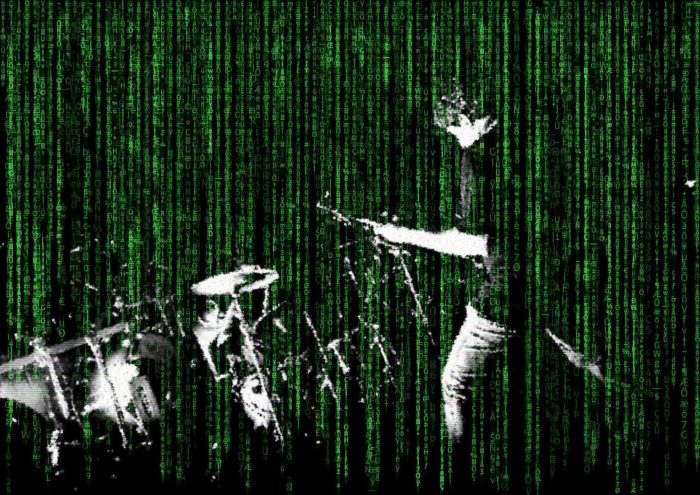Virtual soundchecks are a neat idea, but in reality they have lots of limitations.
Please Remember:
The opinions expressed are mine only. These opinions do not necessarily reflect anybody else’s opinions. I do not own, operate, manage, or represent any band, venue, or company that I talk about, unless explicitly noted.

 Want to use this image for something else? Great! Click it for the link to a high-res or resolution-independent version.
Want to use this image for something else? Great! Click it for the link to a high-res or resolution-independent version.Before we dive in to anything, let’s go over what I’m not saying:
I’m not saying that virtual soundchecks can never be useful in any situation.
I’m not saying that you shouldn’t try them out.
I’m not saying that you’re dumb for using them if you’re using them.
What I am definitely saying, though, is that the virtual soundcheck is of limited usefulness to folks working in small rooms.
What The Heck Is A Virtual Soundcheck?
A virtual soundcheck starts with a recording. This recording is a multitrack capture of the band playing “live,” using all the same mics and DI boxes as would be set up for the show. The multitrack is then fed, channel-per-channel, into a live-sound console. The idea is that the audio-human can tweak everything to their heart’s delight, without having the band on deck for hours at a time. The promise is that you can dial up those EQs, compressors, and FX blends “just so,” maybe even while sitting at home.
This is a great idea. Brilliant, even.
But it’s flawed.
Flaw 1: Home is not where the show is.
It may be possible to make your headphones or studio monitors sound like a live venue. You may even be able to use a convolution reverb to make a playback system in one space sound almost exactly like a PA system in another space. Unless you go to that trouble, though, you’re mixing for a different “target” than what’s actually going to be in play during the actual show. Using a virtual soundcheck system to rough things in is plenty possible, even with a mix solution that’s not exactly tailored for the real thing, but spending a large amount of time on tiny details isn’t worth it. In the end, you’re still going to have to mix the concert in the real space, for that EXACT, real space. You just can’t get around that entirely.
As such, a virtual soundcheck might as well be done in the venue it concerns, using the audio rig deployed for the show.
Flaw 2: Live audio is not an open loop.
A virtual soundcheck removes one of the major difficulties involved in live audio; It opens the feedback loop. Because it’s all driven from playback which the system output cannot directly affect, it’s immune from many of the oddities and pitfalls inherent with mics and speakers that “talk” to each other. A playback-based shakedown might lead an operator to believe that they can crank up the total gain applied to a channel with impunity, but physics will ALWAYS throw the book at you for trying to bend the rules.
The further implication is that “going offline” is about as helpful to the process of mixing wedge monitors as a house stuffed with meth-addled meerkats. In-ears are a different story, but a huge part of getting wedges right is knowing exactly what you can and can not pull off for that band in that space. Knowing what you can get away with requires having the feedback loop factored in, but a virtual check deletes the loop entirely.
Flaw 3: We’re not going to be listening to only the sound rig.
As I’ve been mentioning here, over and over, anybody who has ever heard a real band in a real room knows that real bands make a LOT of noise. Even acoustic shows can have very large “stage wash” components to their total acoustical output. A virtual soundcheck means that the band isn’t there to make noise, and so your mix gets built without taking that into account. The problem is that, in small venues, taking the band’s acoustical contribution into account is critical.
And yes, you could certainly set up the feeds so that monitor-world also gets fed – but that still doesn’t fully fix the issue. Drummers and players of amplified instruments have a lot to say, even before the roar of monitor loudspeakers gets added. This is even true for “unplugged” shows. If the PA isn’t supposed to be drowningly loud, you might be surprised at just how well an acoustic guitar can carry.
As I said before, the whole idea is not useless. You can certainly get something out of playback. You might be able to chase down some weird rattle or other artifact from an instrument that you couldn’t find when everything was banging away in realtime. Virtual soundchecks also become much more helpful when you’re in a big space, with a big PA that’s going to be – far and away – the loudest thing that the audience is listening to.
For those of us in smaller spaces, though, the value of dialing up a simulation is pretty small. For my part, the whole point of soundcheck is to get THE band and THE backline ready for THE show in THE room with THE monitors and THE Front-Of-House system. In my situation, a virtual soundcheck does none of that.